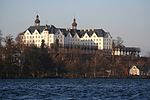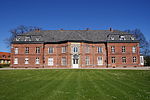Plön Evolution Path

The Max Planck Institute for Evolutionary Biology's Plön Evolution Path ("Plöner Evolutionspfad", German pronunciation: [ˈpløːnɐ evoluˈt͡si̯oːns pfaːt]) is an educational public works project that presents the history and evolution of life on Earth. It is one of a number of Evolution Paths in Germany. Located in Plön, Germany, the Evolution Path is composed of 11 dual-language English/German stations extending around the Großer Plöner See. The path extends 1.3 km in total, starting at the Plön Market Bridge (Schiffsanlegestelle Plön) that also serves as the start of the Plön Planet Walk, and makes its way to the Max Planck Institute for Evolutionary Biology. From beginning to end, the Evolution Path describes events during evolutionary history, beginning with the origin of life (3.8 million years ago) up until the evolution of man (5 million years ago). The distance between each station is proportional to the time interval between the corresponding evolutionary periods described at that station. The exhibition was officially inaugurated on the 14th of September, 2018, in celebration of the 70th anniversary of the Max Planck Society.
Excerpt from the Wikipedia article Plön Evolution Path (License: CC BY-SA 3.0, Authors, Images).Plön Evolution Path
Marktbrücke,
Geographical coordinates (GPS) Address Nearby Places Show on map
Geographical coordinates (GPS)
| Latitude | Longitude |
|---|---|
| N 54.156667 ° | E 10.417222 ° |
Address
Marktbrücke
Marktbrücke
24306
Schleswig-Holstein, Germany
Open on Google Maps










